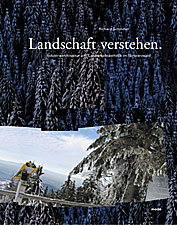 |
Richard
Schindler
UNDERSTANDING LANDSCAPE.
Industrial Architecture and Landscape Aesthetics
in the Black Forest (in german)
2005
284 pages, 107 col. and 110 b/w illus., 2 fold-out pl., 27 x 21 cm,
hardcover, sewn binding, dust jacket
Price: 36 euros
ISBN 3-937014-30-6 |
|
The first comprehensive, model landscape analysis using combined
artistic and scientific approaches. Commissioned on the occasion of
a conflict over wind turbines erected in the Black Forest. Can a
landscape be understood? Is it possible to understand a forest? If
so, how is this understanding be formulated?
Indeed, understanding a landscape is essential in evaluating the
impact of construction projects on their surroundings, all the more
so if the latest standards of landscape protection and preservation
are to be respected.
This book shows how the image of a landscape can be understood and
aesthetically evaluated in clear artistic and scientific terms.
The degree to which industrial architecture is allowed to affect
the landscape has become a topic of public debate worldwide.
Constructions such as hotel towers in the mountains, wind turbines
in rural areas, and duty-free roads through recreational greenbelts
force us to call the aesthetic price of industrial development into
question. Is there an objective way to assess the "disfigurement" of
a landscape? Are there rational criteria for the promotion of
landscape protection or the evaluation of a landscape? What
determines our perception of an "intact" landscape in the first
place?
To answer these questions, this study critically examines current
quantitative methods of evaluating the landscape and proposes a most
promising alternative. The aesthetic quality of the industrial
object in question was derived from its actual, concrete appearance
in the landscape, yet the approach can be applied to construction
projects on any sensitive site.
Cooperation between business and art has traditionally been limited
to corporate sponsorship, the collecting of artworks, or the
presence of art in office environments with varying degrees of
success. By way of contrast, this study shows how the perceptual
skills and experience of the artist can be applied in practical and
productive ways in implementing business objectives as well.
translated by:
Jean-Marie Clarke
+49 / 7633 82639
denkmaler@t-online.de |